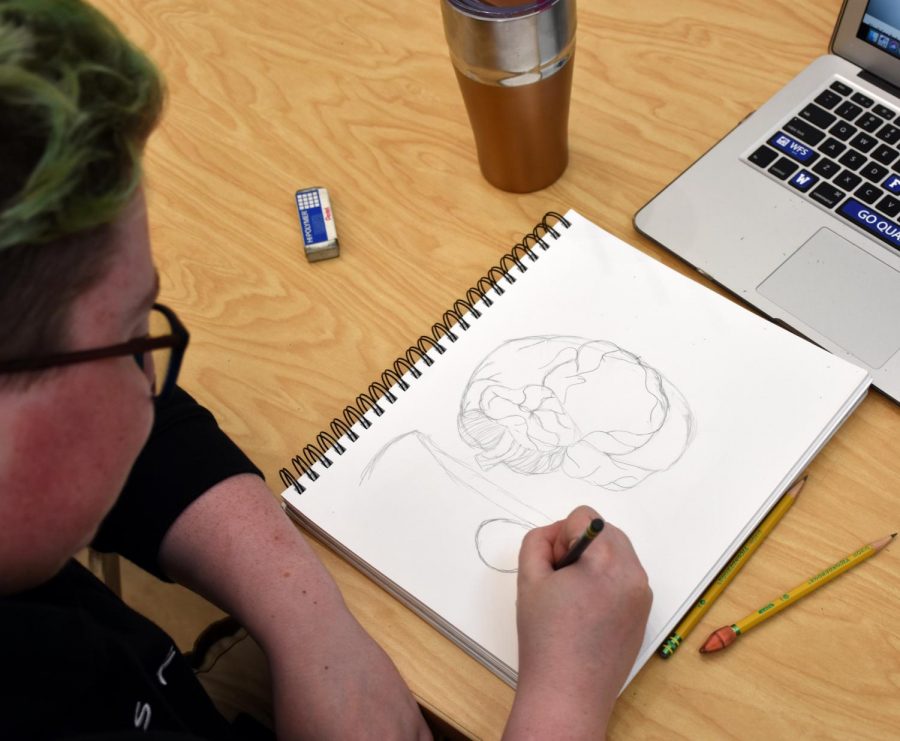The State Of The Arts
October 12, 2019
“The secret to doing anything is believing that you can do it.” Bob Ross, American painter and host of the television show “The Joy of Painting,” is experiencing a renaissance. He is the focus of a new art club at Friends, the Bob Ross Club, clerked by students Zoë Wishengrad and Manon Magnan de Bellevue. “The club is supposed to be an inclusive place,” said Magnan, “where people can come to relax and have a good time, and to admire Bob Ross.” This is just one of the many ways in which the arts at Friends affects the vibrant community at Friends.
In conjunction with the newly formed club, the visual arts at Wilmington Friends continues to impact the community and curriculum of the Middle and Upper Schools. Students in all divisions explore their ideas, emotions, and themes from other classes. Through various projects, they enrich their understanding of the visual arts across multiple disciplines. Indeed, this year alone, one hundred and ten upper school students will take some form of visual arts class, like the required Visual Arts Foundations course for freshman, in-depth courses on 3D art, the Visual Arts Major course, and the IB art course. These classes each reflect a distinct approach and encourage active dynamism and innovation in the world of the visual arts.
In the Middle School, the visual arts classes are comprised of fundamental keystones of the academic curriculum, such as earth science and English. All students participate in the obligatory Visual Arts ‘encore’ class, guided by the Middle School visual arts teacher, Paulo Machado, the chair of the Visual Arts Department at Friends. “Arts promote a form of outward thinking—the projects and processes are inspired by real-world connections,” said Machado. “The three-year course attempts to investigate the unique roles of visual arts in today’s society.” Projects include the sustainable housing unit, wherein students learn about the theories of sustainable architecture and design 2D and 3D models of environmentally-friendly homes. These model homes are complete with gardens, solar panels, and wind turbines. The seventh graders complete a digital “uplifting public message project,” wherein they each come up with an inspiring, motivational sentence or phrase and display it against a related backdrop. These are then displayed by the main entrance of the school, where they warm all of our hearts while catching our attention. “The public message project is not about technique,” Machado said. “It’s about ideas. Art is conceived in the heart, in the mind. It is propelled by emotion into physical form.” Such concepts are evident in the intensely personal projects like the “This Is Me Now” animation, where students have a chance to explore their own experience and personality and come up with a minute-long PowerPoint animation about it. “It’s really meaningful to them,” Machado said. “They get an opportunity to explore themselves and communicate it to others.” This concept of mindfulness is prevalent across multiple fields in the Middle School visual arts classes.
In the Upper School, the visual arts classes continue to promote the personal awareness of one’s life experience, or “schema,” as well as a multimedia approach. Cynthia Stan Mellow, easily the longest-tenured teacher at Friends with an impressive forty-two years of experience, teaches several visual arts classes for all four grades of high school. “Ninth graders take the Visual Arts Foundations course, which allows them to demonstrate creativity in multiple forms, across various mediums.” This course lays the foundations, which is evident in the name, for the higher-level classes, principally the Visual Arts Major and IB Higher-Level Art. In fact, Violet’s Lobby has, just this past month, served as a gallery to a collection of posters from the IB HL and VAM art courses. The assignment was to “demonstrate the effects of climate change using a lava lamp.” The results were stunning and inquisitive, both visually and mentally. The Earth engulfed in flames, melting, or surrounded by various climate change-related headlines, were some common themes. “One of the objectives was to show media literacy,” Mellow said. “How do we understand what we’re seeing? Projects like these can help to raise awareness for a larger issue.”
“Look at how many math, science, and English teachers we have,” Machado said. “How many art teachers do we have? One per division.” But why? “Visual Arts is one of the most applicable courses at Friends; having these visual skills is critical in today’s society, and in many careers,” Mellow said. “And for many ninth-graders, VAF is the last art class they’ll ever take.” In the past, the required arts credit for graduation used to be two. Now, it’s only one and a half. Theoretically, that’s two years of visual arts courses that students are no longer required to take. “Art class enrollment is declining in the Upper School,” Mellow said. “Our culture tells them that it’s less important than, say, science or math.” And not just in the wider world, where “artist” is not commonly seen as a viable career. “Our competitor schools all have more art teachers than us,” Mellow said. Machado agreed. “What message does that about our values send to our students, our faculty, and the wider world?” How can we continue to advocate for the Visual Arts program at Friends so that students will remain engaged and excited about the visual arts for years to come? As Bob Ross said, “I can’t think of anything more rewarding than being able to express yourself to others through painting. Exercising the imagination, experimenting with talents, being creative; these things, to me, are truly the windows to your soul.”































